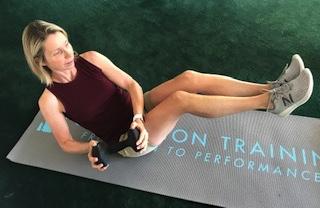Five Common Health and Fitness Mistakes to Avoid - Some May Surprise You!

1. Spending lots of time on “core work” to reduce abdominal fat.
Spot reduction just doesn’t work. If you are unhappy with the amount of abdominal fat you have, cleaning up your diet by getting rid of the processed food, and adding more fruits and vegetables is key. You may also want to adjust your workout routine by adding some challenging aerobic interval training twice per week and focusing on total body strength which will be much more effective than doing extra crunches.
As a side note, if you do the exercise demonstrated in the photo, I recommend that you stop! Look for an upcoming blog post about how to safely and effectively strengthen your core.
2. Adding more aerobic exercise will help you lose weight.
This is a biggie. I have had overweight clients who want to start training for a long -distance event like a marathon or other long -distance event in the hopes that they will lose weight in the process. It almost never happens. It doesn’t happen because more exercise just increases appetite and you can end up eating more calories than what you burn. Training for the event is great, just don’t expect weight loss.
If weight loss is your goal, then turn your focus to cleaning up your diet. Focus on healthy changes more than just calorie reduction. The science is overwhelming, exercise is critical for optimal health, but it is not the best weight loss strategy.
3. Not prioritizing strength training, especially as you age.
We lose muscle mass and bone as we age. Beginning at age 30, you start to lose 3%-5% per decade. This leads to muscle weakness and less mobility that increases your risk of falls.
Maintaining muscle mass also helps your posture, can prevent injury, helps stabilize blood sugar levels, and improves body image. Two times per week for 30-45 minutes using whole body movements done with intensity will help increase your muscle mass.
4. Focusing on protein too much.
Americans get more than double the amount of protein needed for a healthy diet and eat less than half of the fiber needed for good health. We have the focus totally backwards. According to the Harvard School of Public Health’s guidelines, 25% of our plate should contain a protein like lean chicken or fish, legumes, nuts, or tofu, 50% should be fruits and vegetables and 25% whole grain. Focus on the protein package. A vegetable-based protein will contain health benefiting fiber and low or no saturated fat. Animal based proteins contain no fiber and have an abundance of saturated fat.
Athletes do need a bit more protein, but as their activity level goes up so does their appetite. As athletes consume more food, they will get the additional protein needed.
5. Not making sleep a priority.
I strongly recommend Dr. Mathew Walker’s book, “Why We Sleep.” Read it and you will become a believer in making sleep a top priority.
Sleep is hardly passive. We need to sleep to solidify memories and new information, and process emotions. The stress hormone cortisol decreases and growth hormone increases during sleep. We absolutely need at least 7-8 hours of sleep per night. If you struggle with getting enough sleep, find a program or psychologist who is trained in Cognitive Behavioral Therapy for sleep for help.
